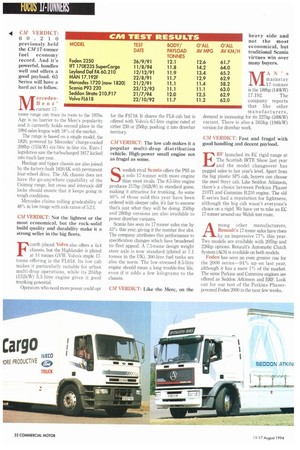MercedesBenz' current 17tonne range can trace its roots to the
Page 32

If you've noticed an error in this article please click here to report it so we can fix it.
1970s. Age is no barrier to the Merc's popularity and it currently holds second place in the 1994 sales league with 18% of the market.
The range is based on a single model, the 1820, powered by Mercedes' charge-cooled 208hp (155k1V) six-litre in-line six. Eurol legislation saw the turbocharged 1817 kicked into touch last year.
Haulage and tipper chassis are also joined by the factory-built 1820AK with permanent four-wheel drive. The AK chassis does not have the go-anywhere capability of the Unimog range, but cross and interaxle diff locks should ensure that it keeps going in tough conditions.
Mercedes claims rolling gradeability of 48% in low range with axle ratios of 5.2:1. Volvo FL618
CM VERDICT: Not the lightest or the most economical, but the rock-solid build quality and durability make it a strong seller in the big fleets.
Fourth placed Volvo also offers a 4x4 chassis, but the Highlander is plated at 14 tonnes GVW Volvo's staple 17tonne offering is the FL618. Its low cab makes it particularly suitable for urban multi-drop operations, while its 204hp (152kW) 5.5-litre engine gives it good trunking potential.
Operators who need more power could opt for the FS718. It shares the FL6 cab but is offered with Volvo's 6.7-litre engine rated at either 230 or 256hp, pushing it into drawbar territory.
CM VERDICT: The low cab makes it a popular multi-drop distribution vehicle. High-power small engine not as frugal as some.
Swedish rival Scania offers the P93 as a solo 17-tonner with more engine than most rivals. The 8.5-litre engine produces 217hp (162kW) in standard guise, making it attractive for trunking. As some 40% of those sold this year have been ordered with sleeper cabs, it's fair to assume that's just what they will be doing. 250hp and 280hp versions are also available to power drawbar variants.
Scania has seen its 17-tonner sales rise by 43% this year, giving it the number five slot. The company attributes this performance to specification changes which have broadened its fleet appeal. A 7.5-tonne design weight steer axle is now standard (plated at 7.1 tonnes in the UK). 300-litre fuel tanks are also the norm. The low-stressed 8.5-litre engine should mean a long trouble-free life, even if it adds a few kilograms to the chassis.
CM VERDICT: Fast and frugal with good handling and decent payload.
ERF launched its EC rigid range at The Scottish IRTE Show last year and the model changeover has pegged sales to last year's level. Apart from the big plastic SP5 cab, buyers can choose the steel Steyr cab. Like Seddon Atkinson, there's a choice between Perkins Phaser 210TI and Cummins R210 engine. The old E-series had a reputation for lightness, although the big cab wasn't everyone's choice on a rigid. We have yet to take an EC 17-tonner around our Welsh test route.
Among other manufacturers, Renault's 17-tonne sales have risen by an impressive 77% this year. Two models are available with 205hp and 226hp options. Renault's Automatic Clutch System (ACS) is available on both models.
Foden has seen an even greater rise for the 2000 series-94% up on last year, although it has a mere 1% of the market. The same Perkins and Cummins engines are offered as Seddon Atkinson and ERE Look out for our test of the Perkins Phaserpowered Foden 2000 in the next few weeks..














































































